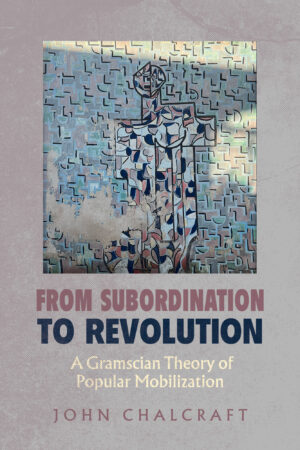Is There a Way to Fight Back?
By John Chalcraft, author of From Subordination to Revolution: A Gramscian Theory of Popular Mobilization
Republished with permission from the London School of Economics and Political Science Blog.
We can howl miserably about the multiple crises of the present – from authoritarian populism to neoliberal inequality, and from ecocide to genocide. But what if we are asked to say what mobilizing for an alternative looks like? How can the great many who oppose neoliberal capitalism, colonialism, and neofascism overcome their many weaknesses and divisions and build for fundamental social transformation?
My new book offers one answer to these vexing questions by presenting a thorough new theory of popular mobilization, based on the writings of the Italian revolutionary intellectual, Antonio Gramsci (d. 1937), on Gramscian research, and on case studies from all over the world.

The key aim, at a time of mass discontent and revolutionary weakness, is to put forward a theory capable of connecting diverse subaltern mobilizations – rather than prioritizing one subordinated group, or descending into a cacophony of difference.
The point is to enable us to think an articulation (i.e. linking together) of struggles capable of understanding and fertilizing revolutionary change.
The book responds to the pitfalls of conventional theory. Liberal theories, for example, based on human rights, law, development, and humanitarianism, are criticized for their failure to break with individualism, capitalism, bourgeois professionalization, state power, and forms of liberal imperialism. Studies of social movements and contentious politics are viewed as abstract, sterile, and incapable of theorizing hegemony or fundamental transformation. Conservative theories arguably repeat or amplify the stifling hegemonic common sense that confirms or intensifies subalternity.
The book builds on critical theories, while arguing that Marxism, for all its importance, is dogged by materialism and authoritarianism. It also maintains that poststructuralist, cultural, intersectional, and decolonial approaches, for all their dynamism and significance, often lack political content.
Developed and satisfying alternatives, however, are few. Everyday forms of resistance have been seen as a panacea, but this is foreshortening and de-politicizing. Changing the world without taking power, however inspiring, is eventually naïve. The long march through the institutions regularly dissolves into reformism. While seizing state power by force dead ends in vanguardism and authoritarianism. Revolutionary politics looks either untenably violent or tyrannical, or it has been domesticated as merely a matter of mass demonstrations that fail to bring structural change. Deconstruction, and negative critique, however, is not enough: it can be a high road to disabling scepticism, political detachment and despair.
The novel start point for an alternative is an appreciation of the originality of the living Gramscian tradition. The book argues that Gramsci’s intervention is assimilable neither to Marxism nor German/Italian idealism. Gramsci forged a new synthesis of Bartoli, Croce, Hegel, Lenin, Machiavelli, Marx, and Sorel. He engaged in a great re-thinking, especially in his Prison Notebooks (Quaderni del Carcere), amid not only the crisis of liberal-capitalism, and the ascendancy of fascism and colonialism, but also the problems of Marxism.
Gramsci’s oeuvre offers not dialectical materialism but a philosophy of praxis, defined as the organic unification of theory and practice; not capitalism alone, but a politics of hegemony, defined as the combination of coercion and consent; and not the industrial proletariat as the sole historical vanguard, but a much more diverse history of subaltern social groups, defined as those at the margins of history.
Gramsci’s original, historicizing dialectics enables us to connect – across oppositions, distinctions and separations – theory and practice, the material and the ideal, subject and object, class and group, knowing and feeling, capitalism and culture, civil society and the state, and the national and the colonial.
Gramscian theory has travelled and been updated around the world by anticolonial, feminist, queer, anti-racist, radically democratic, and ecological thought and activism. It can now be considered a living tradition, unassimilable to poststructuralism, culturalism or to the various returns of Marxism – not to mention new forms of conservative and religious politics.
The originality of the Gramscian living tradition is often lost, however, in the dominant readings of Gramsci as Marxist, neo-Crocean, Lacanian, discursive, Foucauldian, contradictory, or as merely a culture warrior. But this originality holds great potential for theorizing popular mobilization, above all because it enables us to get beyond divisions based on materialism and idealism, and to conceptualize and connect the fundamentals, faces and phases of popular mobilization, without reductionism or shapelessness.
As for fundamentals, the book defines popular mobilization as the many ways in which subordinated groups re-arrange their relationships to challenge and overcome social domination. It argues that core here is revolutionizing praxis – the coincidence of self-changing and the changing of circumstances. Such praxis involves renewal and unification, and is intertwined with the activities of organic intellectuals, formed on the terrain of class and group, and engaged in expression, construction, organization and leadership.
The various faces of revolutionizing praxis include transformations in social being and social consciousness (encompassing class, gender, race and sexuality), the structural re-making of civil society, culture, economy and the state, spatio-temporal integration, the strategic construction of popular forces, and the expansion of the transnational terrain.
The book also draws on Gramsci’s powerful concept of the phase – a configuration of relations – to analyse distinct and even opposite (but never entirely separated) situations in the long journey from subordination to revolution.
Gramsci writes of how subaltern groups must achieve autonomy from dominant forces before winning consent, defeating enemies, building a bloc, and eventually bringing about a revolution.
The book is structured around the dynamics of the four major phases of this complex morphology, understood respectively to involve ‘the torturous contradictions of domination’, the ‘wellsprings of autonomy’, the ‘expansive search for consent’ and the ‘roiling ferment of revolution’.
Hegemony is remade, it is claimed, by the thorough transformation of its key moments: dominazione (domination), autonomia (autonomy), consenso (consent) and direzione (leadership).
The book builds on this framework to advance its main arguments. Regarding dominazione, the aim is to convince readers that ‘everyday’, fragmented resistance at the margins is neither liberation nor illusion, but an indispensable premise for subsequent forms of mobilization.
Regarding autonomia, the book argues that the drive for autonomy amid crisis is neither the millennium nor a ‘youthful error’ but a vital phase to be built on.
Regarding consenso, the argument is that the search for consent can successfully steer between vanguardism and reformism, above all through both social bloc formation and the activities of an ‘organic party’, which is distinguished sharply from the Leninist vanguard Party and the mass, democratic party.
Regarding direzione, the book argues that the twin dangers of Caesarism and passive revolution can be avoided, and the revolution can have an organic and popular-democratic formulation, above all when we conceive the hegemon to be neither class, party, state nor sole leader, but the historical bloc.
Overall, the book claims that the living Gramscian tradition can underpin a rich theorization of popular mobilization that gets us beyond authoritarian-populism, liberalism, social movements theory, materialist/authoritarian Marxism, anarchist autonomism, poststructuralist culturalism and negative critique.
The book closes with a discussion of practical implications, linking the theory to the larger goal of fertilizing forces capable of engaging mass discontent, overcoming pervasive Left weakness and division, and challenging the ascendancy of the Right.
At its widest, I hope that this theory of popular mobilization will be of interest to all those in academia and beyond who are concerned with the potential, amid the crisis of neoliberal capitalism, for transnational, democratic, socialist renewal.
